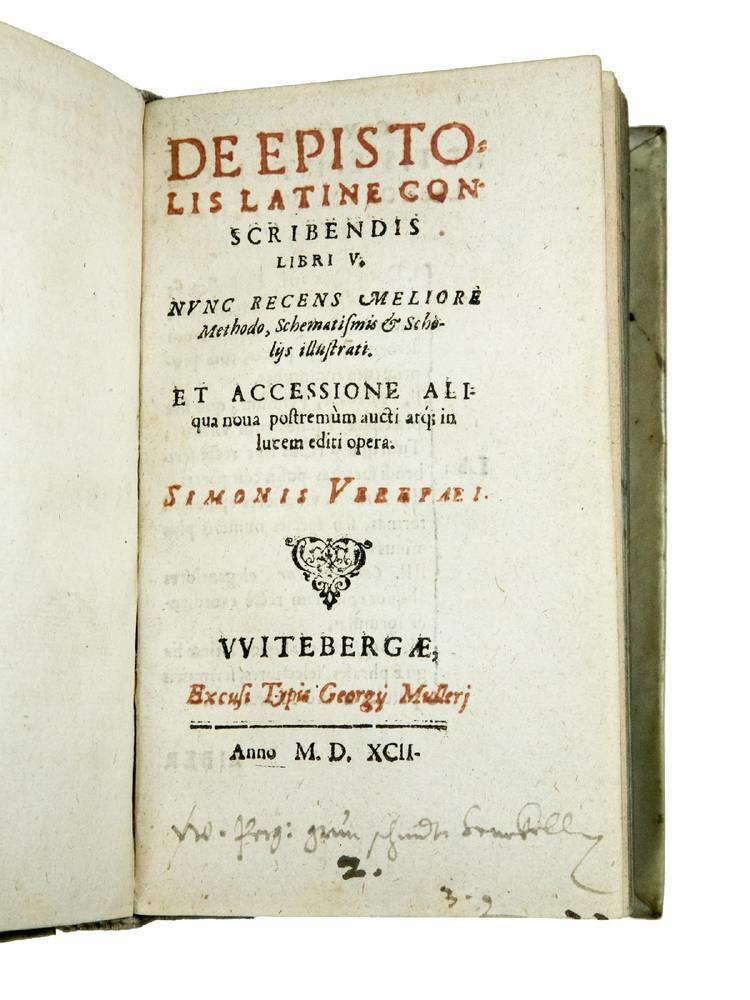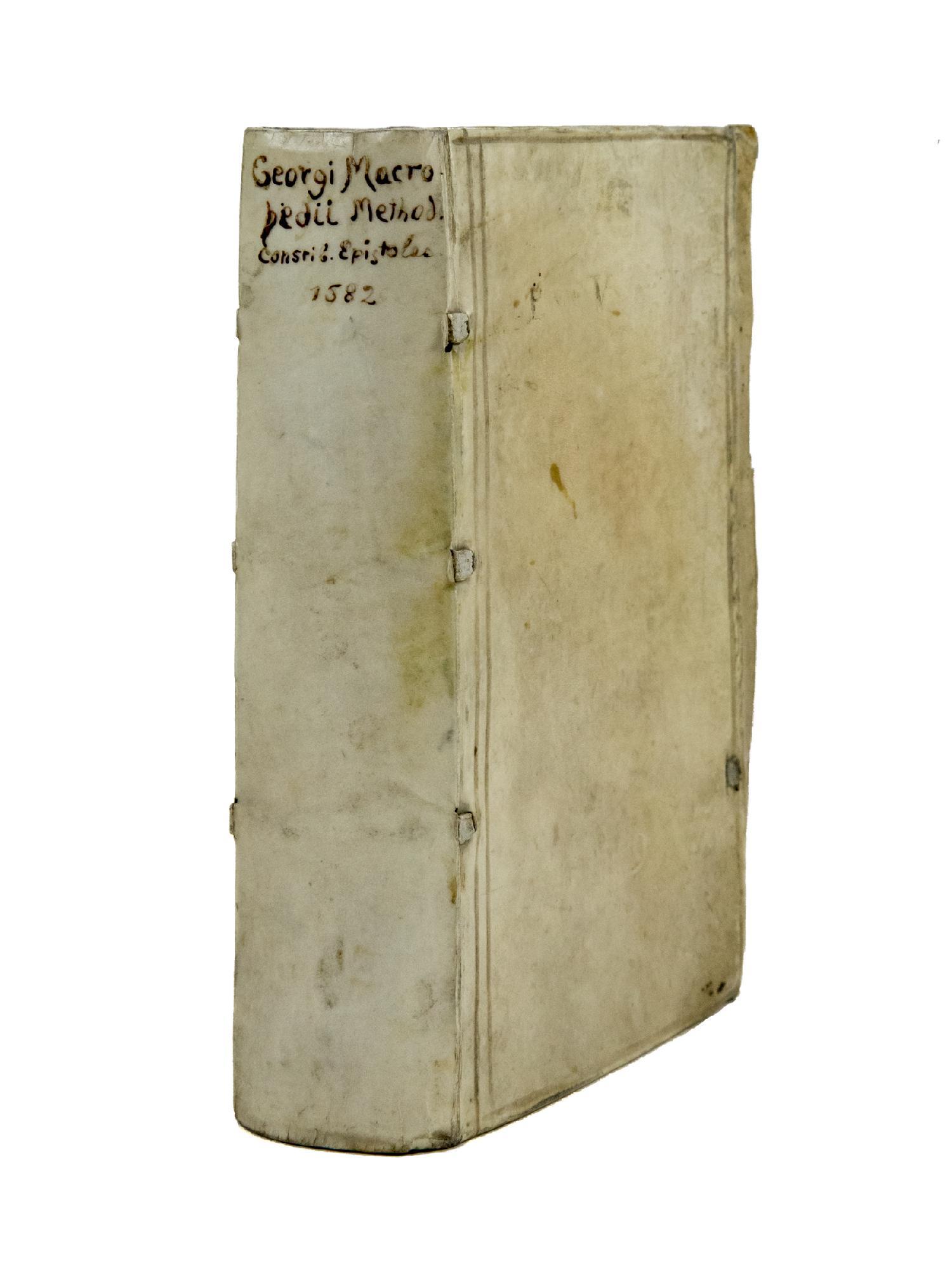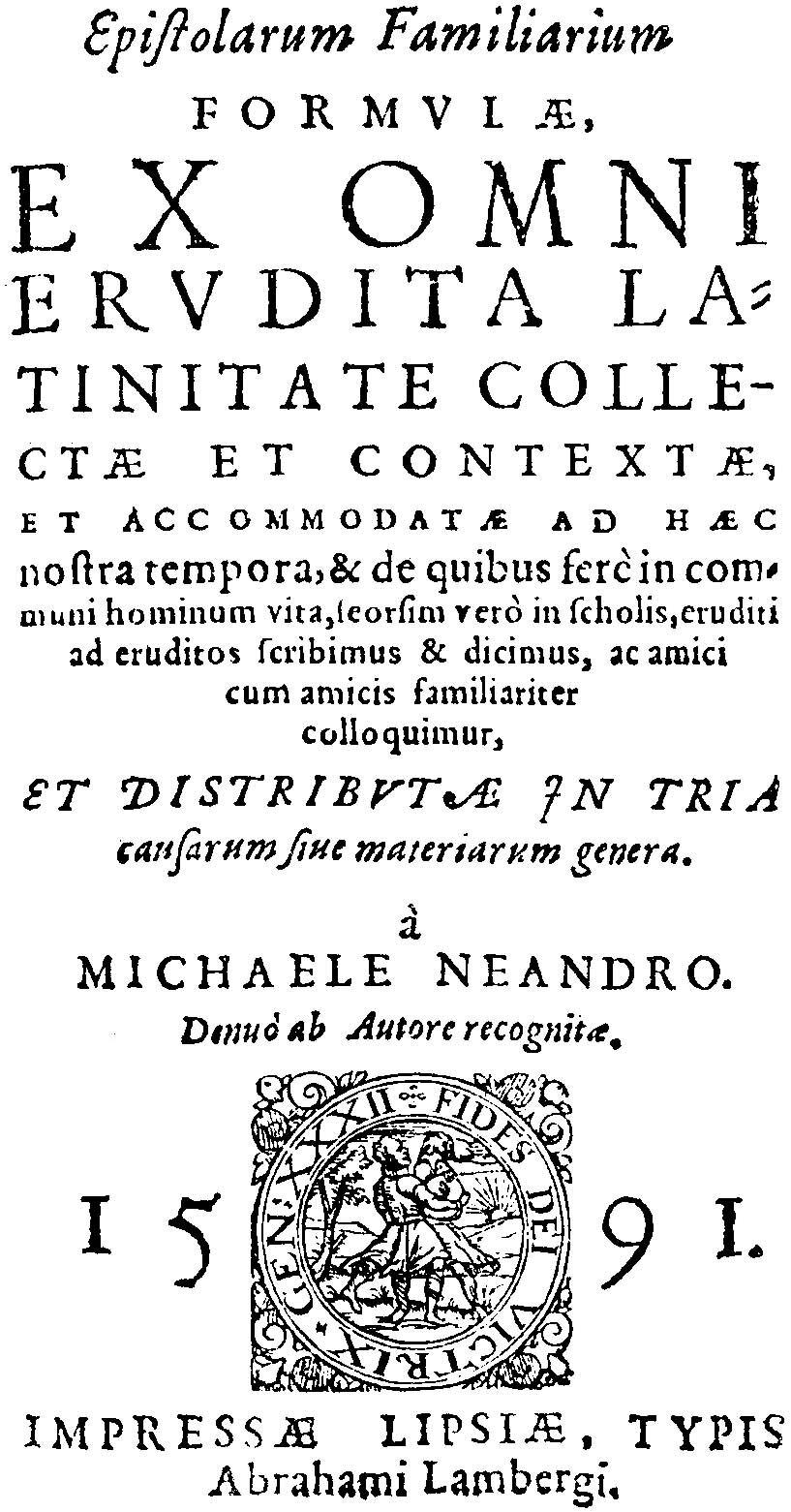Methodus conscribendi epistolas, secundum veram artis rationem tradita. Eiusdem Epitome praeceptionum de paranda copia verborum & rerum, per quaestiones: item de novem speciebus argumentationum Rhetoricarum, rem omnem breviter explicans. Accessit Chr
Three works in one volume, 8vo. Contemporary vellum over boards, blind-stamped fillets on the panels with the lettering P.V.B 1597 on the front panel, old entries of ownership on the title-page. Ex libris Franz Pollak-Parnau.
_x000D__x000D_
I. MACROPEDIUS:
_x000D_(2), 123 [i.e. 125], (1) leaves. A-Q8 (Q8 is a blank). With the printer's device on the title-page. Catalogo unico, IT\ICCU\BVEE\021641.
_x000D_RARE EDITION. This is a literal reprint of the Birckmann edition of 1568. Macropedius' most successful textbook, dedicated to the youth of Utrecht, on the art of letter writing was first published as Epistolica at Antwerp by Hillen in 1543 and after his death under the title Methodus conscribendi epistolas in 1561 at Dillingen. Added to this edition for the first time was the tract Epitome praeceptionum de paranda copia verborum & rerum, per quaestiones, which was falsely attributed to Macropedius, and, in fact, was written by Johannes Rivius (1500-1553) and first published at Wesel in 1548.
_x000D_Printed at the end is also Christoph Hegendorff's (1500-1540) Modus conscribendi epistolas; this is a literal reprint of the edition that appeared in Hagenau in 1526.
_x000D_“Macropedius' Epistolica is divided into two parts, the first treating the invention, the second, disposition and elocution. Although Macropedius does not acknowledge Erasmus, in the first part he draws on the Opus de conscribendis epistolis in prescribing forms of greeting, address, and farewell and in classifying letters. He names five categories; demonstrative, deliberative, judicial, didascalicum or dialecticum (Erasmus' letter of discussion), and indicativum (Erasmus' extraordinary or family class). Macropedius provides his own sample letters, and he is more rigid in applying rhetorical precepts to letter writing than Erasmus. Although he concedes that the structure of the letter varies with the type of argument, he nevertheless defines for each type except the familiar or formal structure based on the divisions of the oration. This is a procedure that Erasmus had criticized in Francesco Negro's De modo epistolandi. Macropedius emphasizes art much more, individual judgment and the demands of decorum much less, than Erasmus” (J. Rice Henderson, Humanism and the Humanities. Erasmus's ‘Opus de conscribendis epistolis' in Sixteenth Century Schools, in: “Letter-Writing Manuals and Instruction from Antiquity to the Present”, C. Poster & L.C. Mitchell, eds., Columbia, SC, 2007, p. 158).
_x000D_Georgius Macropedius was born as Joris van Langhvelt in Gemert (North Brabant, the Netherlands). Little is known about his boyhood. After having attended the parish school he moved to s'-Hertogenbosch. Here, he attended the local grammar school and lived in one of the boarding-houses of the Brothers of the Common Life. In 1502, at the age of fifteen, he became a member of the fraternity and prepared for a career in teaching. About ten years later he was ordained and started teaching Latin at the municipal grammar school. In the years 1506–1510 he had already started writing Latin plays for his students. The first drafts of his drama Asotus (The Prodigal Son) date from this period. He took on a classic name, as was the custom among sixteenth century humanists: Joris became Georgius and Van Langhvelt was translated into Macropedius.
_x000D_In 1524 he was appointed headmaster of St. Jeromès in Liège. In 1527 Macropedius returned to 's-Hertogenbosch a
Venditore:

Informazioni:
<p>Three works in one volume, 8vo.&nbsp; Contemporary vellum over boards, blind-stamped fillets on the panels with the lettering P.V.B 1597 on the front panel, old entries of ownership on the title-page. Ex libris Franz Pollak-Parnau.</p> <p>&nbsp;</p> <p><strong>I. MACROPEDIUS</strong>:</p> <p>(2), 123 [i.e. 125], (1) leaves. A-Q<sup>8</sup> (Q8 is a blank). With the printer's device on the title-page. Catalogo unico, IT\ICCU\BVEE\021641.</p> <p>RARE EDITION. This is a literal reprint of the Birckmann edition of 1568. Macropedius' most successful textbook, dedicated to the youth of Utrecht, on the art of letter writing was first published as <em>Epistolica</em> at Antwerp by Hillen in 1543 and after his death under the title <em>Methodus conscribendi epistolas</em> in 1561 at Dillingen. Added to this edition for the first time was the tract <em>Epitome praeceptionum de paranda copia verborum &amp; rerum, per quaestiones</em>, which was falsely attributed to Macropedius, and, in fact, was written by Johannes Rivius (1500-1553) and first published at Wesel in 1548.</p> <p>Printed at the end is also Christoph Hegendorff's (1500-1540) <em>Modus conscribendi epistolas</em>; this is a literal reprint of the edition that appeared in Hagenau in 1526.</p> <p>&ldquo;Macropedius' <em>Epistolica</em> is divided into two parts, the first treating the invention, the second, disposition and elocution. Although Macropedius does not acknowledge Erasmus, in the first part he draws on the <em>Opus de conscribendis epistolis</em> in prescribing forms of greeting, address, and farewell and in classifying letters. He names five categories; demonstrative, deliberative, judicial, <em>didascalicum</em> or <em>dialecticum</em> (Erasmus' letter of discussion), and <em>indicat
Immagini:



-
Editore:
-
Tipologia:
- Prodotto usato
- Condizioni: Usato - In buone condizioni
Le schede prodotto sono aggiornate in conformità al Regolamento UE 988/2023. Laddove ci fossero taluni dati non disponibili per ragioni indipendenti da Feltrinelli, vi informiamo che stiamo compiendo ogni ragionevole sforzo per inserirli. Vi invitiamo a controllare periodicamente il sito www.lafeltrinelli.it per eventuali novità e aggiornamenti.
Per le vendite di prodotti da terze parti, ciascun venditore si assume la piena e diretta responsabilità per la commercializzazione del prodotto e per la sua conformità al Regolamento UE 988/2023, nonché alle normative nazionali ed europee vigenti.
Per informazioni sulla sicurezza dei prodotti, contattare productsafety@feltrinelli.it

